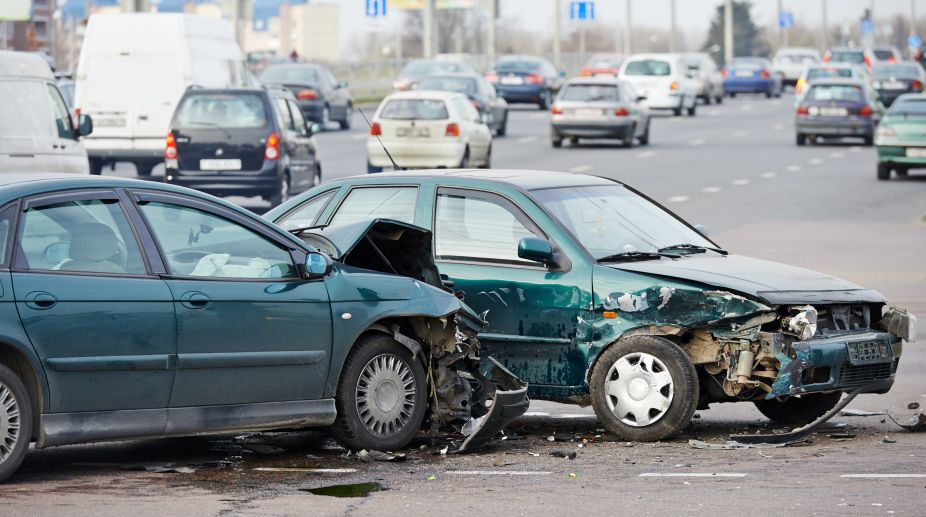Two killed in separate road mishaps
An elderly man and a two-year-old girl were killed in two separate road accidents due to reckless driving. The incidents led to agitation and road blocks in the respective areas.

PHOTO: Getty Images
Road accidents have increased to such an extent in India that almost anyone one meets can recall a recent tragedy among friends and acquaintances. Official data on road accidents is serious in itself but it tells only part of the story as it misses out on most of the injuries caused by road accidents.
First, let’s look at the official data provided by the National Crime Records Bureau (NCRB), which in turn is based on road accident data sent by police stations all over the country. This data tells us that as many as 1,41,526persons died and 4,77,731 were injured in road traffic accidents in India in 2014. What is more, while the number of road accidents at the world level did not increase significantly during the first 15 years of this century, in India from 2001 to 2014 the number of road accidents increased by about 75 per cent from 80,900 to 1,41,526 during this period.
This increase is often blamed on increase in the number of vehicles but there are many countries which were able to avoid an increase in the number of road accidents despite a big increase in vehicles. The number of on-the-road vehicles in India is estimated to be about 55% of the registered vehicles after adjusting for the phased-out vehicles. On this assumption the personal vehicle ownership per 100 population in Australia is 12 times the number in India. Similarly, the vehicle ownership rate is 9 to 11 times higher in Canada, Greece, Japan, Portugal, Sweden and the UK, but the road traffic fatality rate in all these countries is significantly less than in India.
Advertisement
While presenting this data, the Status Report on Road Safety in India (2015) prepared by the Transportation Research and Injury Prevention Programme of the Indian Institute of Technology, Delhi, has also quoted several studies which indicate that while the official data on road traffic accidents may be only moderately under-reported, the extent of under-reporting is likely to be much higher in the case of road accident injuries. This is confirmed further by the much higher number of injuries recorded per fatality in the reporting of road accidents from several countrieswhere reporting is known to be better. Trying to work out the most likely figures on the basis of the existing studies,this IIT report estimates that for every fatality there are likely to be 15 serious injuries and 50 minor injuries related to road traffic accidents. This works out to about 21 lakhserious injuries and about 70 lakh minor injuries.
The success already achieved by several countries in reducing road traffic accidents as well as the potential for this in India indicates that if well planned and determined efforts with the involvement of people are made, then it should be possible to reduce fatalities and injuries by about half of existing levels. Hence, to start with, a potential certainly exists to prevent about 70,000 deaths and about 45 lakh injuries related to road traffic accidents in a year.
The Global Status Report on Road Safety has identified five key risk factors for legislation on road safety~ speed, drink-driving, motor cycle helmets, seat belts and child restraints. In addition, this report has emphasisedspecial provisions to protect pedestrians and cyclists. The IIT report has presented more detailed recommendations keeping in view the specific conditions of India. This report has also indicated how the existing treatment of all road accidents under present-day legal arrangements leads to situations in which the cause of the crash has to be recorded as a fault of a driver under one or more of the legal provisions. “This procedure ensures that 80% or more of the cases get attributed to ‘human error’ and there is no place for understanding crashes as a result of a host of factors, including vehicle, road and infrastructure design.”
However, such factors can be very important, as was pointed out recently in a research paper titled ‘Automobile Manufacturers, Advertising and Traffic Safety in India’ by Prof. Dinesh Mohan and Abhaya Jha. These researchers drew attention to the fact that various Indian cars failed the 2014 Global New Car Assessment Programme Tests. “… What these results mean is that in a frontal crash of over 50 km./hour the occupants of these cars have a high probability of being injured critically. These results inform us in a graphic manner that very unsafe cars are being marketed in India with the knowledge of the manufacturers and government officials.”
While powerful interests have to be confronted to improve some important aspects of road safety, in some other areas important gains can be made by strong and well-planned public campaigns. This is true for reducing drink driving and sleepiness related driving as well as use of mobile phones while driving. In the UK, 20 % of accidents on motorways are caused by sleepiness alone.
On the whole there is enormous potential for reducing road accidents in India and serious action on this front should not be delayed any longer.
The writer is a free-lance journalist who has been involved with several social initiatives and movements.
Advertisement